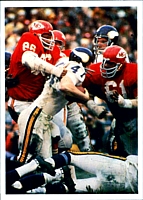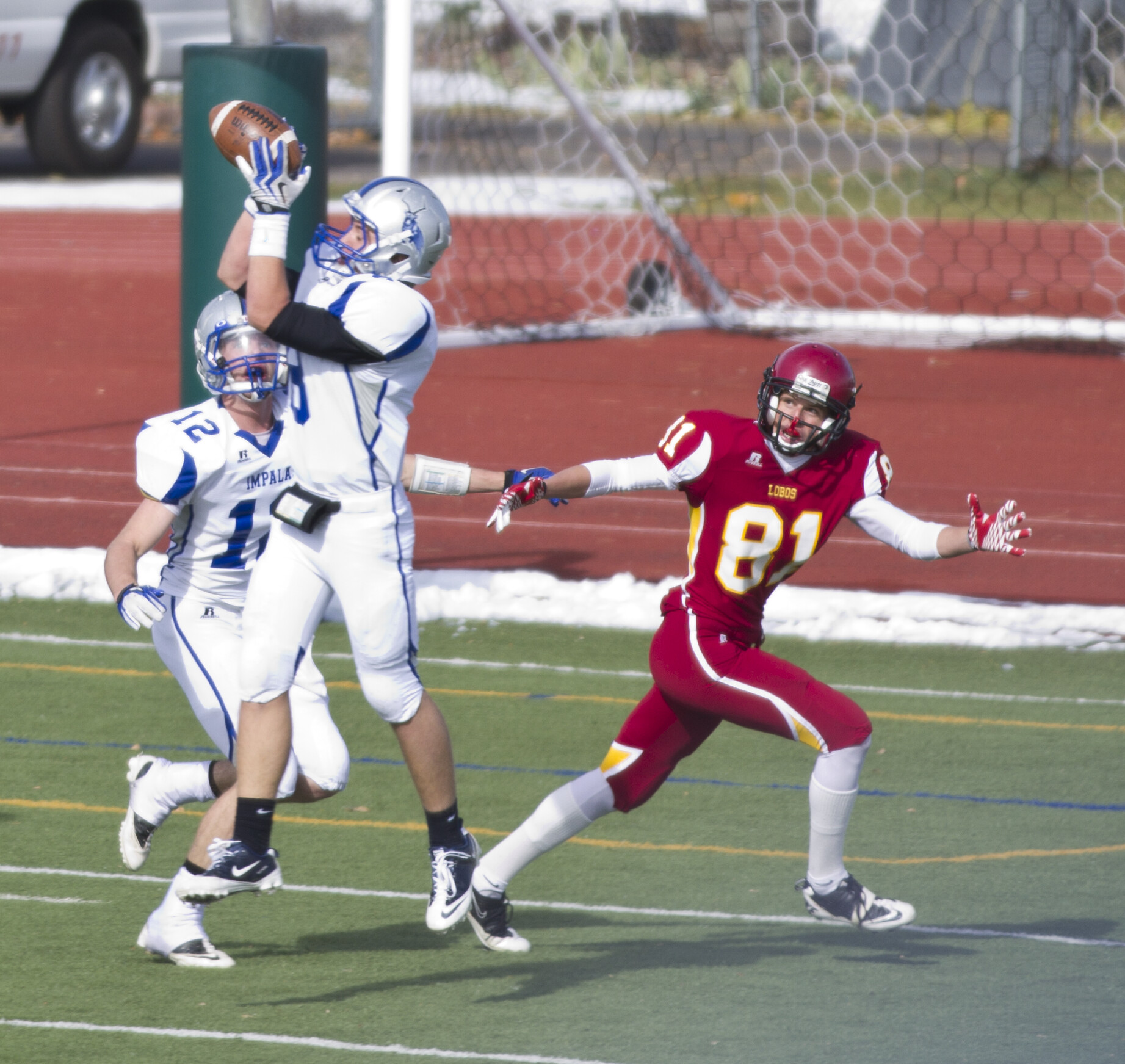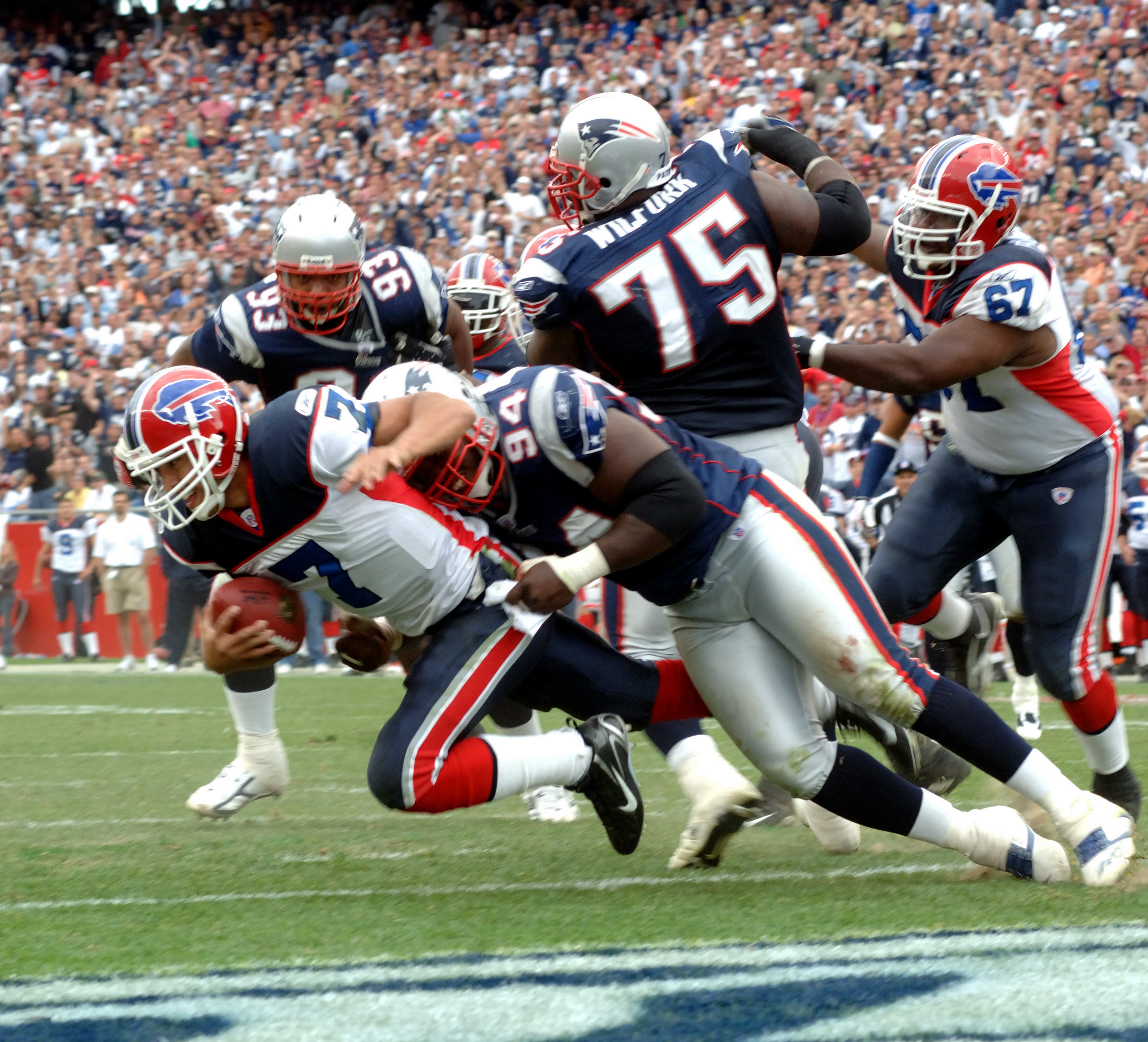|
Buck Buchanan
Junious "Buck" Buchanan (September 10, 1940 – July 16, 1992) was an American professional football player who was a defensive tackle with the Kansas City Chiefs in the American Football League (AFL) and in the National Football League (NFL). Buchanan was inducted into the College Football Hall of Fame in 1996 and the Pro Football Hall of Fame in 1990. Buchanan was massive for his era, standing at 6'7", and weighing 270 lbs. His height gave him a big advantage against lineman in the trenches. High school years Buchanan attended A. H. Parker High School in Birmingham, Alabama, and was a standout in football and basketball. College years Buchanan attended Grambling College in Louisiana and was a letterman in football and an NAIA All-America selection. He was inducted into the College Football Hall of Fame in 1996. He is one of four Grambling State players, Willie Brown, Willie Davis, and Charlie Joiner coached by Eddie Robinson enshrined in the Pro Football Hall of Fame. ... [...More Info...] [...Related Items...] OR: [Wikipedia] [Google] [Baidu] |
Defensive Tackle
A defensive tackle (DT) is a position in American football that will typically line up on the line of scrimmage, opposite one of the offensive guards, however he may also line up opposite one of the tackles. Defensive tackles are typically the largest and strongest of the defensive players. Depending on a team's individual defensive scheme, a defensive tackle may be called upon to fill several different roles. These roles may include merely holding the point of attack by refusing to be moved, or penetrating a certain gap between offensive linemen to break up a play in the opponent's backfield. If a defensive tackle reads a pass play, his primary responsibility is to pursue the quarterback, or simply knock the pass down at the line if it is within arm's reach. Other responsibilities of the defensive tackle may be to pursue the screen pass or drop into coverage in a zone blitz scheme. In a traditional 4–3 defense, there is no nose tackle. Instead there is a left and right defensi ... [...More Info...] [...Related Items...] OR: [Wikipedia] [Google] [Baidu] |
1969 AFL Championship Game
The 1969 AFL Championship Game was the tenth and final championship game of the American Football League, and the league's final game prior to its merger with the National Football League on February 1, 1970. The game was held on January 4, 1970, at the Oakland-Alameda County Coliseum between the Western Division champion Oakland Raiders (12–1–1) and the division's second-place team, the Kansas City Chiefs (11–3). The two teams had the best records in the AFL regular season and both had won divisional playoff games two weeks earlier to advance to the championship. Oakland had swept the two hard-fought regular season games between the two teams, were favored by 4 to 5½ points, and had taken seven of the last eight meetings. Tied at halftime, the Chiefs won 17–7 on the strength of seventeen unanswered points in the last three quarters and represented the AFL in Super Bowl IV the following week. This was the 616th and final AFL game. Game summary The Chiefs edged o ... [...More Info...] [...Related Items...] OR: [Wikipedia] [Google] [Baidu] |
American Football
American football (referred to simply as football in the United States and Canada), also known as gridiron, is a team sport played by two teams of eleven players on a rectangular field with goalposts at each end. The offense, the team with possession of the oval-shaped football, attempts to advance down the field by running with the ball or passing it, while the defense, the team without possession of the ball, aims to stop the offense's advance and to take control of the ball for themselves. The offense must advance at least ten yards in four downs or plays; if they fail, they turn over the football to the defense, but if they succeed, they are given a new set of four downs to continue the drive. Points are scored primarily by advancing the ball into the opposing team's end zone for a touchdown or kicking the ball through the opponent's goalposts for a field goal. The team with the most points at the end of a game wins. American football evolved in the United States, ... [...More Info...] [...Related Items...] OR: [Wikipedia] [Google] [Baidu] |
Interception
In ball-playing competitive team sports, an interception or pick is a move by a player involving a pass of the ball—whether by foot or hand, depending on the rules of the sport—in which the ball is intended for a player of the same team but caught by a player of the team on defense, who thereby usually gains possession of the ball for their team. It is commonly seen in football, including American and Canadian football, as well as association football, rugby league, rugby union, Australian rules football and Gaelic football, as well as any sport by which a loose object is passed between players toward a goal. In basketball, a pick is called a steal. American/Canadian football In American football and Canadian football, an interception occurs when a forward pass that has not yet touched the ground is caught by a player of the opposing defensive team. This leads to an immediate change of possession during the play, and the defender who caught the ball can immediately attem ... [...More Info...] [...Related Items...] OR: [Wikipedia] [Google] [Baidu] |
Safety (gridiron Football Score)
In gridiron football, the safety (American football) or safety touch (Canadian football) is a scoring play that results in two points being awarded to the scoring team. Safeties can be scored in a number of ways, such as when a ball carrier is tackled in his own end zone or when a foul is committed by the offense in their own end zone. After a safety is scored in American football, the ball is kicked off to the team that scored the safety from the 20-yard line; in Canadian football, the scoring team also has the options of taking control of the ball at their own 35-yard line or kicking off the ball, also at their own 35-yard line. The ability of the scoring team to receive the ball through a kickoff differs from the touchdown and field goal, which require the scoring team to kick the ball off to the scored upon team. Despite being of relatively low point value, safeties can have a significant impact on the result of games, and Brian Burke of Advanced NFL Stats estimated that s ... [...More Info...] [...Related Items...] OR: [Wikipedia] [Google] [Baidu] |
Quarterback Sack
In gridiron football, a sack occurs when the quarterback (or another offensive player acting as a passer) is tackled behind the line of scrimmage before throwing a forward pass, when the quarterback is tackled behind the line of scrimmage in the " pocket" and without clear intent, or when a passer runs out of bounds behind the line of scrimmage due to defensive pressure. This often occurs if the opposing team's defensive line, linebackers or defensive backs are able to apply pass pressure (also called a pass rush) to quickly get past blocking players of the offensive team (the quarterback's protection), or if the quarterback is unable to find a back to hand the ball off to or an available eligible receiver (including wide receivers, running backs and tight ends) to catch the ball, allowing the defense a longer opportunity to tackle the quarterback. Performing a sack is advantageous for the defending team as the offense loses a down, and the line of scrimmage retreats several ... [...More Info...] [...Related Items...] OR: [Wikipedia] [Google] [Baidu] |
1962 Little All-America College Football Team
The 1962 Little All-America college football team is composed of college football players from small colleges and universities who were selected by the Associated Press (AP) as the best players at each position. For 1962, the AP selected three teams of 11 players each, with no separate defensive platoons. Tackle Buck Buchanan was the largest player at 6'6" and 272 pounds; he was the No. 1 pick in the 1963 AFL Draft. Buchanan played 13 seasons for the Kansas City Chiefs and was inducted into the Pro Football Hall of Fame. Quarterback George Bork of Northern Illinois was the only junior. He was the first college player to pass for 3,000 yards in a season and was later inducted into the College Football Hall of Fame. End Drew Roberts of Humboldt State and back Joe Iacone of West Chester were the only repeaters on the first team from 1961. Iacone rushed for 1,486 yards in 1962. First team * Back - Joe Iacone (senior, 5'9", 190 pounds), West Chester * Back - George Bork (junior ... [...More Info...] [...Related Items...] OR: [Wikipedia] [Google] [Baidu] |
Little All-America Team
The Little All-America team is an honor given annually to the best small college players at their respective positions. The first Little All-America team for college football, selected with assistance from reporters in every region, was announced in December 1934 by Edward J. Neil of the Associated Press (AP). Neil wrote that the Little All-America team was intended to honor "the little fellows, players in hundreds of colleges who labored just as earnestly, often with just as much ability, but barely edging into the spotlight . . ." Players who received Little All-America honors (years in parenthesis) and were later inducted into the Pro Football Hall of Fame include: Joe Stydahar (1934), Bulldog Turner (1939), Tony Canadeo (1939), Andrew Robustelli (1949), Buck Buchanan (1962), Willie Lanier (1965), Terry Bradshaw (1969), Walter Payton (1974), and Shannon Sharpe (1989). Other notable Little All-Americans include Otis Taylor (1964), Carl Garrett (1966, 1967, 1968), Billy "Whit ... [...More Info...] [...Related Items...] OR: [Wikipedia] [Google] [Baidu] |
American Football League All-Time Team
The American Football League (AFL) All-Time Team was selected on January 14, 1970. The first and second teams were determined by a panel of members of the AFL's Hall of Fame Board of Selectors: Offense Defense Special teams Coach See also * List of American Football League players The following is a list of men who played for the American Football League (AFL, 1960–1969). Players A B C D Elbert Dubenion E F G H I J K L M N O P Q R S T U V W Y Z Notes Player notes 1,398 ... Notes References {{NFLdecade ... [...More Info...] [...Related Items...] OR: [Wikipedia] [Google] [Baidu] |
1969 All-AFL Team
This is a list of players named as All-Pros based on their performance in the 1969 AFL and NFL season. These lists provide a perspective into how players were judged against their peers by critics of their time. Players representing both the National Football League (NFL) and American Football League (AFL) are included. Selectors Teams were selected by several publications and wire services: the Associated Press (AP), the Pro Football Hall of Fame (HoF), the Newspaper Enterprise Association (NEA), the New York Daily News (NYDN), Pro Football Weekly (PFW), the Pro Football Writers of America (PFWA), the Sporting News (SN) and the United Press International (UPI). The Hall of Fame and PFWA each selected a true "All-Pro" team which included players from ''both'' the NFL and AFL. The AP, Daily News and UPI all selected one team for ''each'' league, which are referred to as "All-NFL" and "All-AFL" teams. The NEA and Pro Football Weekly each named both a unified All-Pro team as wel ... [...More Info...] [...Related Items...] OR: [Wikipedia] [Google] [Baidu] |
1964 All-AFL Team
The 1964 American Football League All-League Team was selected after the 1964 American Football League (AFL) season by AFL players, the Associated Press (AP), the Newspaper Enterprise Association (NEA), the ''New York Daily News'' (NYDN), and United Press International United Press International (UPI) is an American international news agency whose newswires, photo, news film, and audio services provided news material to thousands of newspapers, magazines, radio and television stations for most of the 20th ... (UPI) to honor the league's top performers at each position. Teams References * {{American Football League All-League players All-League Players American Football League All-League players ... [...More Info...] [...Related Items...] OR: [Wikipedia] [Google] [Baidu] |
All-AFL
''The Sporting News'' published an American Football League All-League Team, often referred to as All-AFL, for each season played by the American Football League (AFL), 1960 through 1969. From 1960 through 1966, the All-League team was selected by the AFL players, and from 1967 through 1969 it was selected by a consensus of ''The Sporting News'' (''TSN''), the Associated Press (AP), United Press International (UPI), and the Newspaper Enterprise Association The Newspaper Enterprise Association (NEA) is an editorial column and comic strip newspaper syndication service based in the United States and established in 1902. The oldest syndicate still in operation, the NEA was originally a secondary news ... (NEA). The AFL All-League selections usually included one player at each team position on offense and on defense (i.e., one quarterback, two guards, four defensive backs, etc.). Seasons External links [...More Info...] [...Related Items...] OR: [Wikipedia] [Google] [Baidu] |





